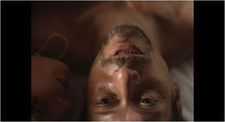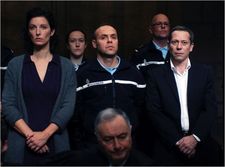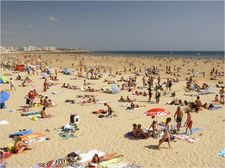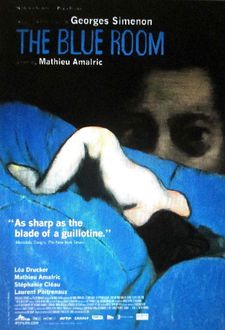 |
| Director and star Mathieu Amalric in The Blue Room: "I thought a lot of the usual suspects. A man sitting and looking, and he is not listening." |
Mathieu Amalric's The Blue Room (La Chambre Bleue) is based on Georges Simenon's novel. Amalric stars with Stéphanie Cléau, Léa Drucker with Serge Bozon, Mona Jaffart, Laurent Poitrenaux and Blutch in his whodunnit with a question mark for each molded part - the who, the done and especially the it.
David Lynch's Lost Highway - William Holden's death - Gene Hackman and Kevin Costner in Roger Donaldson's No Way Out form a thread. Katharine Hepburn on a ladder climbing up to Cary Grant in Howard Hawks' Bringing Up Baby, editing with François Gédigier and Bozon's voice are heard in part 2 of our conversation.
Anne-Katrin Titze: You mentioned how quickly Simenon wrote the book and you also said that you intended to make a quick film. There can be a great quality to those endeavours, art works that have not been thought through to death.
 |
| Julien Gahyde (Mathieu Amalric) bloody lip: "…underneath you can put obsessions." |
Mathieu Amalric: That's what I love about movies. That you just save your life every day, in fact, with a lot of instinct, a lot that you are not really aware of. Even with the bees. We shot two weeks in July and then three weeks in November and the trial was the last scene we shot.
AKT: That was what you meant when you said RKO at the New York Film Festival press conference? The quickness?
MA: Yes, RKO in that way. Small budget, but it's the perfect budget for a film with such a plot. The politeness of having a plot that has to do with suspense, a thriller. But underneath you can put obsessions. I really tried to make a film that had something very simple. Then I saw the film yesterday night. I hadn't seen the film since Cannes. God, it's so tragic!
AKT: What is?
MA: The film is tragic! It's dark! How come? And then at the Q&A I was just making jokes. Excusing myself for having made a film that's so dark. I was just making jokes. It was strange.
AKT: It is a lethal story. There is humor in the film, though.
MA: This man you want to tell to do something. Why is he so much in a prison? Of course, we have thought about the fact that he is a self-made man and that he puts all his energy into making it. And the house, the false paradise. It's a lot of effort for that man. That's from the novel. He is not from the same world she [Esther, Stéphanie Cléau] is, that's also why I called him Julien [as in Stendahl's novel Le Rouge Et Le Noir].
 |
| Stéphanie Cléau as Esther and Julien Gahyde on trial: "He doesn't want to be in danger. And that woman is maybe just a woman in love, really." |
AKT: He pays an immense price. Many people pay a high price.
MA: That is what is beautiful with Simenon, it speaks to what is common to everybody.
AKT: He has an affair and hopes it will all stay contained. Nothing is allowed to become too much.
MA: He doesn't want to be in danger. And that woman is maybe just a woman in love, really. I'm sure, Simenon thought about that, the possibility that she is absolutely innocent. His wife [Delphine], Léa [Drucker], the actress who plays his wife is wonderful. The silence. How come she doesn't say anything? In everyday life we are very close to those situations every day.
AKT: If she said something, she would have to do something. And she doesn't want to rock the boat either. You made the decision to introduce all three interrogators almost at once. You don't allow the audience to grasp Serge Bozon's gendarme first and then move on to the next. We are thrown into the questioning instead.
MA: Yes. Like in the book, you hear, you understand that the guy is being arrested and the scene in the [blue] room is still continuing. In the book there are these voices - "She would bite you often?" "Don't you think she did it on purpose to bite you?" With Stéphanie, I wrote two columns, on screen and off screen. It was like that graphically for two things happening at the same time. Those voices were supposed to be off [camera].
 |
| The Blue Room family holiday: "That is what is beautiful with Simenon, it speaks to what is common to everybody." |
I remember, I also chose Serge for his voice, because it's so different. I love his voice. What I would do is, I would also film all the off, because I know how it is at the editing. Things can change, it's organic, with François [Gédigier] who is the editor. If it was only off, it wasn't stunning enough, it wasn't disturbing enough. That's why we started showing them quickly at the beginning like that.
AKT: There are some interesting parallels between Julien and his interrogators. You show that in glances. On the one hand, children's toys at the police station and on the other hand, the judge [Laurent Poitrenaux] changing his shirt and whatever is going on with his secretary.
MA: Those toys were there! We shot in a real gendarmerie and that dromedary - it was there! You can't invent things like that. That's the only thing that's good when you act in your own film. That I would put myself in that situation. I thought a lot of the usual suspects. A man sitting and looking, and he is not listening. Then I would film all those cables of computers. And the shirt … Simenon loved judges and he hated attorneys, defense lawyers. Words were bullshit but he had a great respect for judges.
He wrote a book called Letter to My Judge. In that scene, there is that contagious thing, that the judge is also a normal person. That's why Julien says, "but you know what it is? I don't have to put words onto what happens in the intimacy of a room. Everybody lives that. You know as well as I." I thought showing the body of this man would say something. We had shot a scene where he was with his wife at his place, the judge. It is in the book.
 |
| The Blue Room US poster |
AKT: You didn't need that scene. The way he looks at the secretary includes all of this. At the press conference I asked you about the scene on the ladder because it stood out to me. Most of the other scenes have a sort of double in how they connect to other scenes, they mirror each other. A woman on a ladder always makes me think of Katharine Hepburn in Bringing Up Baby. There is some humor in this scene, too. What was it that struck you so hard at the screening?
MA: It's a man in prison in his head, who doesn't open himself. Neither to his daughter, nor to the love for his wife, nor to the passion with Esther. Of course, it has to do with an autobiographical concern. Am I him? Am I in a prison? I don't know, something about the courageousness of living, maybe.
Not just lying to yourself and going along next to your own life. Avoiding, that's really what makes me afraid. And when I saw that, I thought, why did I do this film? I have to be very vigilant. The thing with the ladder was really also the thing about danger, danger, danger. That we would be afraid.
AKT: That glass table made me think of the way William Holden died. And David Lynch's Lost Highway.
MA: Yes, yes, of course, Lost Highway. And I was also thinking of the film [No Way Out] with Gene Hackman and Kevin Costner. Gene Hackman plays the President, he is with his mistress and he just pushes her and she falls. It's a great film, a police film from the Eighties/Nineties.
AKT: They go to the cinema in your film and the wife's question is not, "What movie?", but "What day is today?"
MA: It's Thursday. It's always Thursday.
In part 1, we discussed leaving a message for John Zorn, Georges Simenon's love of Stendahl, working with Director of Photography Christophe Beaucarne and sound engineer Olivier Mauvezin.





















